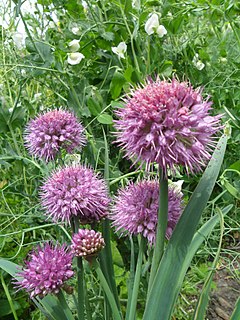
Chives, scientific name Allium schoenoprasum, is a species of flowering plant in the family Amaryllidaceae that produces edible leaves and flowers. Their close relatives include the common onions, garlic, shallot, leek, scallion, and Chinese onion.

Allium monanthum, the Korean wild chive, is a spring vegetable with minuscule bulbous roots that have a mild onion flavor and found in the woodlands of Korea, Japan, northeastern Russia (Primorye), and northeastern China.
Allium atrosanguineum an Asian species of onion native to China, Siberia, Mongolia, and Central Asia. It grows high in the mountains at elevations of 2400–5400 m.

Allium carolinianum is a species of onions native to central and southern Asia. It grows in sunlit slopes at elevations of 3000–5000 m.
Allium fetisowii is a plant species native to Kazakhstan, Uzbekistan, Xinjiang, Kyrgyzstan and Tajikistan in Central Asia.
Allium flavovirens is a species of onions endemic to the western part of Inner Mongolia. It grows in dry places at altitudes of 1800–3100 m.
Allium humile is an Asian species of wild onion found at high elevations in India, Nepal, northern Pakistan, Tibet, and Yunnan.

Allium macranthum is an Asian species of wild onion native to Bhutan, Sikkim, Gansu, Shaanxi, Sichuan and Tibet. It grows in wet places at elevations of 2700–4200 metres.

Allium mongolicum is an Asian species of wild onion native to Mongolia, Inner Mongolia, Tuva, Kazakhstan, and parts of China.

Allium maximowiczii, English common name oriental chive, is an Asian plant species native to Siberia, the Russian Far East, Mongolia, Japan, Korea and northeastern China.
Allium platyspathum is an Asian species of wild onion. It has been reported from Xinjiang, Afghanistan, Kazakhstan, Kyrgyzstan, Mongolia, Altay Krai, Tajikistan, Uzbekistan, and Pakistan. It grows in damp locations at elevations of 1900–3700 m.
Allium polyrhizum is an Asian species of wild onion widespread across Zabaykalsky Krai, Kazakhstan, Mongolia, and China at elevations 1000–3700 m.
Allium roborowskianum is an Asian species of wild onion native to Xinjiang and Mongolia. It grows at elevations of 1000–1300 m.
Allium schoenoprasoides is an Asian species of wild onion native to Xinjiang, Kazakhstan, Kyrgyzstan and Tajikistan. It can be found at elevations of 2700–3000 m.
Allium semenovii is an Asian species of wild onion native to Xinjiang, Kazakhstan, Tajikistan, and Kyrgyzstan. It grows at elevations of 2000–3000 m.

Allium sikkimense is a plant species native to Sikkim, Tibet, Bhutan, Nepal, India and parts of China. It grows in meadows and on the edges of forests at elevations of 2400–5000 m. The species is cultivated as an ornamental in other regions because of its strikingly beautiful blue flowers. It is used medicinally in the Sikkim Eastern Himalayas.
Allium subangulatum is a Chinese species of wild onion, native to Gansu, Ningxia and Qinghai Provinces.
Allium tanguticum is a Chinese species of wild onion native to Gansu, Qinghai and Tibet. It grows at elevations of about 2000–3500 m.
Allium tenuissimum is an Asian species of wild onion native to Mongolia, Asiatic Russia, Korea, Kazakhstan and China.
Allium winklerianum is an Asian species of onion native to Xinjiang, Afghanistan, Tajikistan, Uzbekistan, Kyrgyzstan, and Tajikistan. It is also cultivated as an ornamental elsewhere because of the pretty flowers and also because of the strong lilac scent to the blooms.






